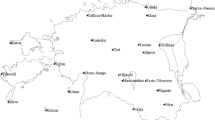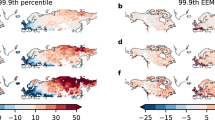Abstract
Mountain snow cover is an important source of water and essential for winter tourism in Alpine countries. However, large amounts of snow can lead to destructive avalanches, floods, traffic interruptions or even the collapse of buildings. We use annual maximum snow depth and snowfall data from 25 stations (between 200 and 2,500 m) collected during the last 80 winters (1930/31 to 2009/2010) to highlight temporal trends of annual maximum snow depth and 3-day snowfall sum. The generalized extreme value (GEV) distribution with time as a covariate is used to assess such trends. It allows us in particular to infer how return levels and return periods have been modified during the last 80 years. All the stations, even the highest one, show a decrease in extreme snow depth, which is mainly significant at low altitudes (below 800 m). A negative trend is also observed for extreme snowfalls at low and high altitudes but the pattern at mid-altitudes (between 800 and 1,500 m) is less clear. The decreasing trend of extreme snow depth and snowfall at low altitudes seems to be mainly caused by a reduction in the magnitude of the extremes rather than the scale (variability) of the extremes. This may be caused by the observed decrease in the snow/rain ratio due to increasing air temperatures. In contrast, the decreasing trend in extreme snow depth above 1,500 m is caused by a reduction in the scale (variability) of the extremes and not by a reduction in the magnitude of the extremes. However, the decreasing trends are significant for only about half of the stations and can only be seen as an indication that climate change may be already impacting extreme snow depth and extreme snowfall.






Similar content being viewed by others
References
Akaike H (1974) A new look at the statistical model identification. Automat Contr IEEE Trans 19(6):716–723
Begert M, Schlegel T, Kirchhofer W (2005) Homogeneous temperature and precipitation series of Switzerland from 1864 to 2000. Int J Climatol 25(1):65–80
Beguería S, Angulo-Martínez M, Vicente-Serrano SM, López-Moreno JI, El-Kenawy A (2010) Assessing trends in extreme precipitation events intensity and magnitude using non-stationary peaks-over-threshold analysis: a case study in northeast Spain from 1930 to 2006. Int J Climatol:n/a-n/a. doi:10.1002/joc.2218
Beniston M, Goyette S (2007) Changes in variability and persistence of climate in Switzerland: exploring 20th century observations and 21st century simulations. Glob Planet Change 57(1–2):1–15
Beniston M, Stephenson D, Christensen O, Ferro C, Frei C, Goyette S, Halsnaes K, Holt T, Jylhä K, Koffi B, Palutikof J, Schöll R, Semmler T, Woth K (2007) Future extreme events in European climate: an exploration of regional climate model projections. Clim Chang 81:71–95. doi:10.1007/s10584-006-9226-z
Blanchet J, Davison AC (2010) Spatial modelling of extreme snow depth. Annals of Applied Statistics, Under revision
Blanchet J, Lehning M (2010a) Mapping snow depth return levels: smooth spatial modeling versus station interpolation. Hydrol Earth Syst Sci 14(12):2527–2544. doi:10.5194/hess-14-2527-2010
Blanchet J, Lehning M (2010b) Mapping snow depth return levels: smooth spatial modeling versus station interpolation. Hydrol Earth Syst Sci Discuss 7(4):6129–6177. doi:10.5194/hessd-7-6129-2010
Blanchet J, Marty C, Lehning M (2009) Extreme value statistics of snowfall in the Swiss Alpine region. Water Resour Res 45:12. doi:10.1029/2009wr007916
Bocchiola D, Medagliani M, Rosso R (2006) Regional snow depth frequency curves for avalanche hazard mapping in central Italian Alps. Cold Reg Sci Tech 46(3):204–221
Bocchiola D, Janetti EB, Gorni E, Marty C, Sovilla B (2008) Regional evaluation of 3 day snow depth for avalanche hazard mapping in Switzerland. Nat Hazards Earth Syst Sci 8(4):685–705
Brown SJ, Caesar J, Ferro CAT (2008) Global changes in extreme daily temperature since 1950. J Geophys Res 113(D5):D05115. doi:10.1029/2006jd008091
Chavez-Demoulin V, Davison AC (2005) Generalized additive modelling of sample extremes. J Roy Stat Soc C Appl Stat 54(1):207–222. doi:10.1111/j.1467-9876.2005.00479.x
Coles S (2001) An introduction to statistical modeling of extreme values. Springer
Cooley D (2009) Extreme value analysis and the study of climate change. Clim Chang 97(1):77–83. doi:10.1007/s10584-009-9627-x
Durand Y, Giraud G, Laternser M, Etchevers P, Merindol L, Lesaffre B (2009) Reanalysis of 47 years of climate in the French Alps (1958–2005): climatology and trends for snow cover. J Appl Meteorol Clim 48(12):2487–2512
Falarz M (2008) Changes in extreme nival conditions in Poland during the second half of the 20th century. Meteorol Z 17:339–344
Fisher RA, Tippett LHC (1928) Limiting forms of the frequency distribution of the largest and smallest member of a sample. Proc Cambridge Phil Soc 24:180–190
Frei C, Schöll R, Fukutome S, Schmidli J, Vidale PL (2006) Future changes of precipitation extremes in Europe. J Geophys Res 111. doi:10.1029/2005JD005965
Fuchs T, Rapp J, Rubel F, Rudolf B (2001) Correction of synoptic precipitation observations due to systematic measuring errors with special regard to precipitation phases. Phys Chem Earth Part A Hydrol Ocean Atmos 26(9):689–693
Goodison BE, Louie PYT, Yang D (1998) WMO solid precipitation measurement intercomparison. Instruments and observing methods, vol 76. WMO, Geneva
Hegerl GC, Hanlon H, Beierkuhnlein C (2011) Climate science: elusive extremes. Nat Geosci 4(3):142–143
Hundecha Y, St-Hilaire A, Ouarda TBMJ, El Adlouni S, Gachon P (2008) A nonstationary extreme value analysis for the assessment of changes in extreme annual wind speed over the Gulf of St. Lawrence, Canada. J Appl Meteorol Clim 47(11):2745–2759. doi:10.1175/2008JAMC1665.1
Hyvärinen V (2003) Trends and characteristics of hydrological time series in Finland. Nord Hydrol 34(1–2):71–90
IPCC (2007) Climate change 2007: synthesis report. Contribution of working groups i, II and III to the Fourth Assessment Report of the Intergovernmental Panel on Climate Change. IPCC, Geneva
Ishizaka M (2004) Climatic response of snow depth to recent warmer winter seasons in heavy-snowfall areas in Japan. Ann Glaciol 38:299–304
Katz RW (2010) Statistics of extremes in climate change. Clim Chang 100(1):71–76. doi:10.1007/s10584-010-9834-5
Klein Tank AMG, Können GP (2003) Trends in indices of daily temperature and precipitation extremes in Europe, 1946–1999. J Clim 16(22):3665–3680. doi:10.1175/1520-0442(2003)016<3665:TIIODT>2.0.CO;2
Kohler J, Brandt O, Johansson M, Callaghan T (2006) A long-term Arctic snow depth record from Abisko, northern Sweden, 1913–2004. Polar Res 25(2):91–113
Kunkel KE, Palecki MA, Ensor L, Easterling D, Hubbard KG, Robinson D, Redmond K (2009) Trends in twentieth-century U.S. extreme snowfall seasons. J Clim 22(23):6204–6216. doi:10.1175/2009JCLI2631.1
Laternser M, Schneebeli M (2003) Long-term snow climate trends of the Swiss Alps (1931–99). Int J Climatol 23(7):733–750. doi:10.1002/joc.912
Leadbetter MR, Lindgren G, Rootzen H (1983) Extremes and related properties of random sequences and processes. Springer, New York
Maraun D, Rust H, Osborn T (2010) Synoptic airflow and UK daily precipitation extremes. Extremes 13(2):133–153. doi:10.1007/s10687-010-0102-x
Marty C (2008) Regime shift of snow days in Switzerland. Geophys Res Lett 35. doi:10.1029/2008GL033998
Scherrer SC, Appenzeller C (2006) Swiss Alpine snow pack variability: major patterns and links to local climate and large-scale flow. Clim Res 32(3):187–199
Scherrer SC, Appenzeller C, Laternser M (2004) Trends in Swiss Alpine snow days: the role of local- and large-scale climate variability. Geophys Res Lett 31. doi:10.1029/2004GL020255
Schmidli J, Frei C (2005) Trends of heavy precipitation and wet and dry spells in Switzerland during the 20th century. Int J Climatol 25:753–771
Serquet G, Marty C, Dulex J-P, Rebetez M (2011) Seasonal trends and temperature dependence of the snowfall/precipitation-day ratio in Switzerland. Geophys Res Lett 38(7):L07703. doi:10.1029/2011gl046976
Valt M, Cianfarra P (2010) Recent snow cover variability in the Italian Alps. Cold Reg Sci Tech In Press, Accepted Manuscript
Yang D, Elomaa E, Tuominen A, Aaltonen A, Goodison B, Gunther T, Golubev V, Sevruk B, Madsen H, Milkovic J (1999) Wind-induced precipitation undercatch of the Hellmann gauges. Nord Hydrol 30(1):57–80
Yang J, Ding Y, Liu S, Liu J-F (2007) Variations of snow cover in the source regions of the Yangtze and Yellow Rivers in China between 1960 and 1999. J Glaciol 53:420–426
Acknowledgements
We thank MeteoSwiss for providing access to the daily snow data. Seraina Grob is acknowledged for her devotion in digitizing old snow data. We are indebted to Jean-Pierre Dulex, who pursued the long-term snow measurements in Leysin without support from either governmental organization. Special thanks go to all the observers: the measurement of extreme snow amounts often has to occur during adverse weather conditions.
Author information
Authors and Affiliations
Corresponding author
Rights and permissions
About this article
Cite this article
Marty, C., Blanchet, J. Long-term changes in annual maximum snow depth and snowfall in Switzerland based on extreme value statistics. Climatic Change 111, 705–721 (2012). https://doi.org/10.1007/s10584-011-0159-9
Received:
Accepted:
Published:
Issue Date:
DOI: https://doi.org/10.1007/s10584-011-0159-9




